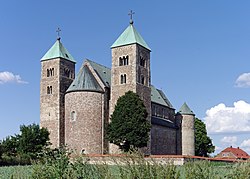Tum | |
|---|---|
Village | |
 Tum Collegiate Church from the 12th century | |
| Coordinates: 52°3′21″N 19°13′58″E / 52.05583°N 19.23278°E | |
| Country | |
| Voivodeship | Łódź |
| County | Łęczyca |
| Gmina | Góra Świętej Małgorzaty |
| Population (approx.) | 600 |
Tum [tum] is a village in the administrative district of Gmina Góra Świętej Małgorzaty, within Łęczyca County, Łódź Voivodeship, in central Poland.[1] It lies approximately 3 kilometres (2 mi) east of Łęczyca and 35 km (22 mi) north-west of the regional capital Łódź. The village has an approximate population of 600.
Tum is the site of a 12th-century Romanesque Collegiate Church as well as a wooden church of Saint Nicholas from the 18th century. On the western edge of the village there are also remains of an early medieval stronghold dating back to the 6th-8th century, which fell into disuse in the 14th century, following the rise of the nearby town of Łęczyca. The stronghold, located about 2 kilometres (1.2 mi) east of the late-medieval town site, was itself known as Łęczyca until then.[2]
References[edit]
- ^ "Central Statistical Office (GUS) – TERYT (National Register of Territorial Land Apportionment Journal)" (in Polish). 2008-06-01.
- ^ Buko, Andrzej (2008). The Archaeology of Early Medieval Poland. Leiden: Brill. p. 180. ISBN 9789004162303.

Well, that’s interesting to know that Psilotum nudum are known as whisk ferns. Psilotum nudum is the commoner species of the two. While the P. flaccidum is a rare species and is found in the tropical islands. Both the species are usually epiphytic in habit and grow upon tree ferns. These species may also be terrestrial and grow in humus or in the crevices of the rocks.
View the detailed Guide of Psilotum nudum: Detailed Study Of Psilotum Nudum (Whisk Fern), Classification, Anatomy, Reproduction